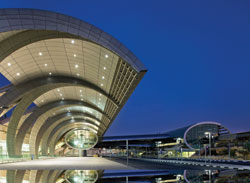
Having experienced passenger growth of 9.2% in 2009, Dubai International Airport anticipates a further 13% growth this year.
As Dubai International Airport has embarked on its major redevelopment plan, it has continued to attract interest around the globe and, thanks largely to the opening of Terminal 3 in 2008, the airport has received no fewer than 15 international awards over the last 24 months; the latest of which was the ‘Best Worldwide Airport’ Award at the Business Travel Awards in February.
“The flawless launch of Terminal 3 in 2008 has earned Dubai immense respect in the global aviation industry, which now looks up to us as the emerging global aviation hub,” said Lorne Riley, airport management, Dubai Airports.
Following impressive passenger growth of 9.2%, to 40.9 million, in 2009, Dubai International Airport anticipates a further 13% growth in 2010. That translates into an annual throughput of 46 million passengers.
Concourse 3
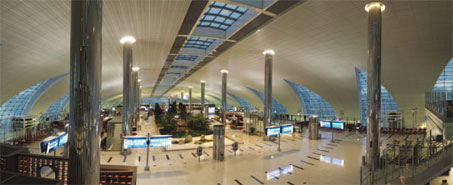
Riley: “We will continue to work toward providing our customers – airlines, passengers, and partners – a safe and secure airport environment, and deliver capacity to support growth and economy.”
The latest stage of the development project is currently in progress and entails the construction of Concourse 3, which will be the world’s first dedicated airside facility for Airbus A380 upon completion towards the end of 2012.
Further works are also ongoing on Al Maktoum International – the first phase of Dubai World Central – which is expected to be ready for cargo operations in June this year. This phase of the project includes a single A380 compatible runway; a passenger terminal with a capacity of five million passengers per annum (expandable to seven million); a cargo terminal building with a capacity of 250,000 tonnes per annum (expandable to 600,000 tonnes) and a 92m-high air traffic control tower.
“We believe it pays to build facilities that keep pace with demand rather than play catch up the other way round,” Riley explained. “We are, therefore, going ahead with our projects as planned to ensure we will be ready for growth. Our mission is to be recognised as the world’s best airport, and the only way to achieve that, and then retain that position, is to keep pushing the envelope, recognise customers’ needs, anticipate global trends and set new standards in customer service.
“We will continue to work toward providing our customers – airlines, passengers, and partners – a safe and secure airport environment, and deliver capacity to support growth and the economy.”
Abu Dhabi plans for Midfield Terminal Complex
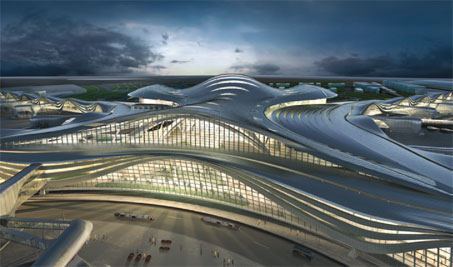
The ongoing expansion project at Abu Dhabi International Airport will see capacity increased to 20 million passengers per year.
Under the guidance of Abu Dhabi Airports Company (ADAC), the expansion project at Abu Dhabi International Airport is continually progressing. As the airport aims to further increase capacity, included in the next stage of the development is the construction of the Midfield Terminal Complex, which is expected to be complete by 2015.
The creation of this new complex was one of the issues discussed at last month’s three-day Abu Dhabi Peer Review Programme, which was hosted by ADAC and attended by leading aviation delegates from around the world.
Following heavy investment in various development and expansion projects in recent years, ADAC is overseeing the current works which include the large-scale expansion of the airport, designed to increase the overall capacity to more than 20 million passengers per year. When complete, the terminal will cover 5.9 million square metres.
As part of the major construction project, a CAT III (B) second runway and a third terminal have already been completed and a new air traffic control tower is due to be fully operational later this year.
Referring to the Peer Review Programme, H.E. Khalifa Al Mazrouei, Chairman of ADAC, said: “As we are currently progressing with our expansion and redevelopment programme at Abu Dhabi International Airport, we feel that by hosting this forum we will benefit from, and continue to foster, a spirit of international cooperation – not just to the advantage of our own development, but of the industry as a whole.”
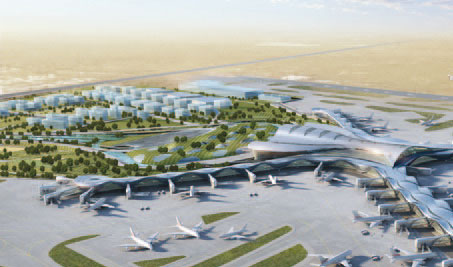
As part of the major construction works, a CAT III (B) second runway and a third terminal have already been completed and a new air traffic control tower is due to be fully operational later this year.
GACA agrees to commercial city at King Abdulaziz Airport
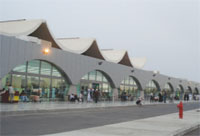
A new commercial city will be constructed at King Abdulaziz International Airport following an agreement between the General Authority for Civil Aviation and the International Financing Company.
Plans to establish a commercial city at King Abdulaziz International Airport (KAIA), located to the north of Jeddah, Saudi Arabia, have been outlined following an agreement between the General Authority for Civil Aviation (GACA) and the International Financing Company.
Having identified two separate locations at KAIA for the creation of commercial centres, conference centres, residential buildings, recreation areas and business offices, GACA has announced that it will meet with investors to discuss investment opportunities to complement the activities of the airport.
The first part of the project will cover an area of approximately one million square metres and will take place to the south of the airport, while the second stage will be to the east of the airport, covering an area of 1.4 million square metres.
As well as the revenue generated directly from the commercial city project, it is also estimated that the development will lead to the creation of more than 34,000 jobs in Jeddah alone, acting as a stimulant to the economic development of Saudi Arabia.
GACA is expected to make a further announcement in May regarding the identity of the investors and the specific details of the investment opportunities.







